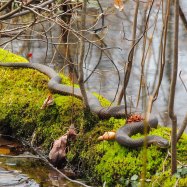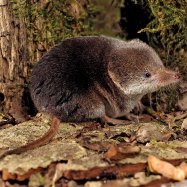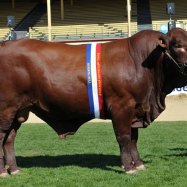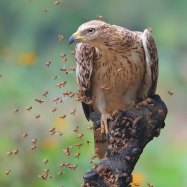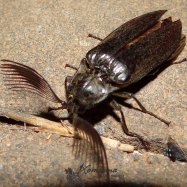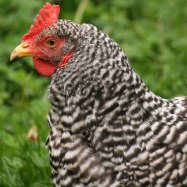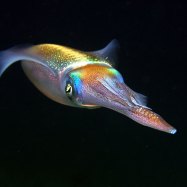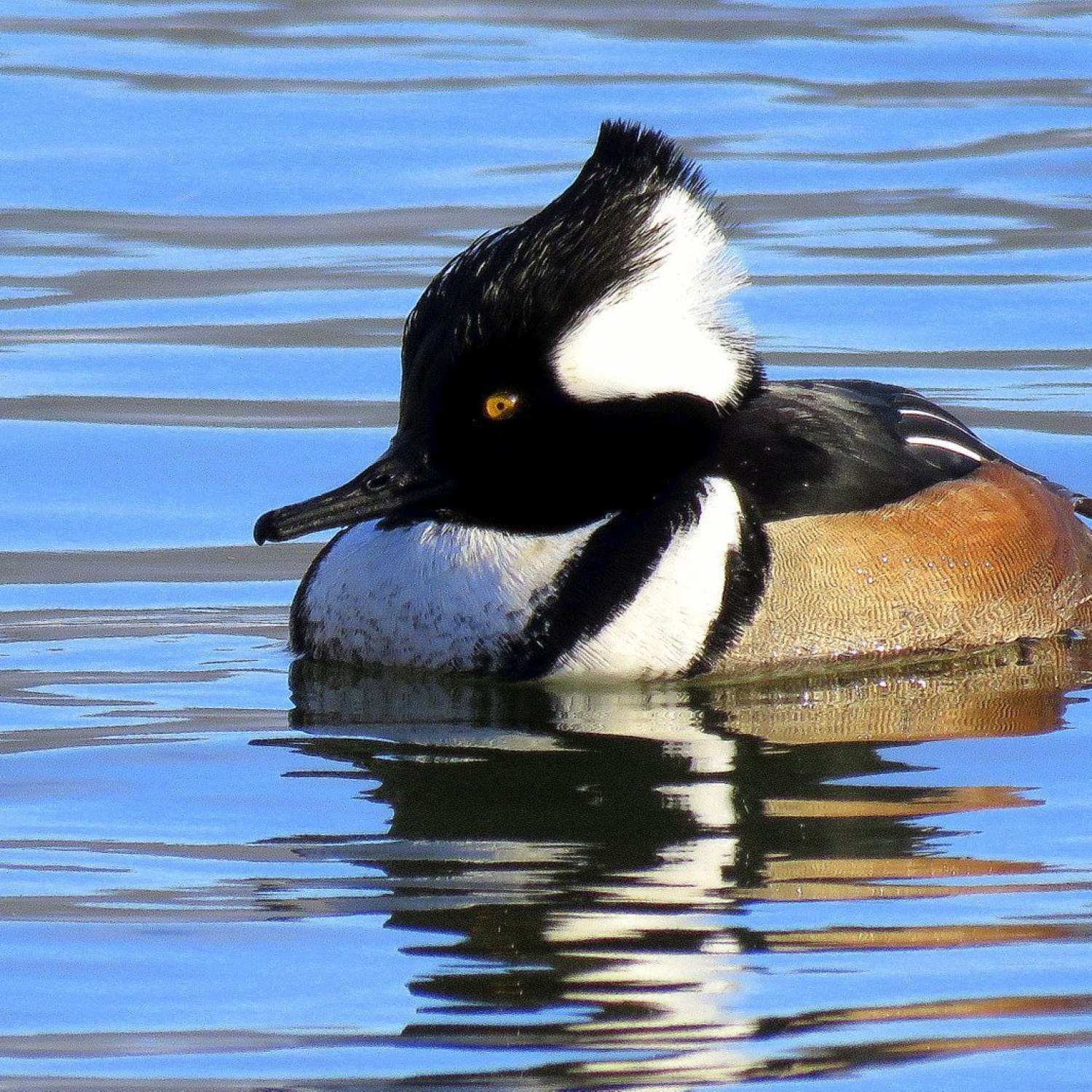
Merganser
20-28 inches (50-70 cm)
The Merganser, a type of waterfowl found in bodies of water, is known for its long, sleek body and slender beak. With a length of 20-28 inches, or 50-70 cm, these medium-sized birds are part of the Anatidae family. Keep an eye out for these beautiful creatures next time you're out near the water! #Merganser #Waterfowl #Anatidae
Animal Details Summary:
Common Name: Merganser
Kingdom: Animalia
Habitat: Freshwater lakes, rivers, and streams
The Fascinating World of the Merganser: An Aquatic Bird Like No Other
Imagine being able to gracefully navigate through clear, freshwater lakes, rivers, and streams while being able to dive deep and catch your own food. Sounds like quite an adventurous lifestyle, doesn't it? It's a lifestyle that the Merganser, also known as Mergus merganser, leads effortlessly in its natural habitat.Mergansers, commonly referred to as "sawbills" due to their characteristic long, saw-toothed bill, are medium-sized aquatic birds that are part of the Anseriformes order, making them related to other waterbirds such as ducks and geese. However, unlike their feathered counterparts, these remarkable birds have some unique qualities that make them stand out in the avian world Merganser.
A Quirky Family
The Merganser belongs to Anatidae, a family of waterbirds that also includes swans and many species of ducks. What makes this family stand out is their distinctive physical features, such as their webbed feet, waterproof feathers, and bills designed for aquatic life. And within this family, the Merganser is surely a standout.The Merganser's Habitat
Mergansers are found across North America, Europe, and Asia, with different species occupying different regions. Some species, like the Hooded Merganser, are found only in North America, while others, like the Red-breasted Merganser, can be found in multiple continents. These birds prefer to inhabit freshwater bodies such as lakes, rivers, and streams, where they can find an abundance of their favorite food.A Carnivorous Diet
Speaking of food, the Merganser's diet is quite different from other waterbirds'. Unlike herbivorous ducks that feed on aquatic plants, the Merganser is a carnivore. These birds love to feast on a variety of fish, crustaceans, and even small amphibians Mosquito. They are incredibly skilled divers, with the ability to plunge up to 20 feet deep in search of their next meal. Their streamlined bodies and waterproof feathers help them move through water with ease, and their long, slender beak aids in catching their prey.Admiring the Colors and Patterns
The Merganser's appearance is nothing short of stunning. Males have a dark green head with a white body and black back, giving them an almost tuxedo-like appearance. In contrast, females have a rusty red head with a gray body. This difference in colors is a common trait amongst many waterbird species, allowing for easier recognition and mate selection.A Body Built for Aquatic Life
The Merganser's body is perfectly suited for its aquatic lifestyle. These birds have a streamlined body shape that allows them to glide through water with minimal resistance, making them efficient divers. Additionally, their webbed feet help propel them through the water, while their long, thin tail acts as a rudder to make sharp turns and sudden dives.Overall Measurements
On average, Mergansers measure around 20-28 inches (50-70 cm) in length, with a wingspan of around 30 inches (76 cm). This medium-sized bird may not be the largest of its kind, but it certainly has an impressive presence.The Mystery Behind the Merganser's Behavior
As intriguing as their physical features and diet may be, the Merganser's behavior is equally fascinating. These birds are highly sociable and can be seen moving in flocks of up to 10 individuals. They are also known for their elaborate courtship displays, where males show off their impressive colors and diving abilities to attract a mate.Interestingly, the Merganser has a unique way of caring for its young. Once the female lays her eggs, she leaves the nest and leaves the male to incubate and raise the chicks. The male also protects the young ones and teaches them vital survival skills, such as hunting and diving, until they are ready to fend for themselves. This unconventional parenting style is a remarkable characteristic of the Mergansers and sets them apart from other waterbirds.
The Merganser's Conservation Status
As with many other animal species, the Merganser has faced some challenges in its natural habitat. Human activities such as pollution, habitat destruction, and overfishing have affected the populations of these birds in some regions. However, thanks to conservation efforts and measures put in place, many species of Merganser are now listed as least concern on the IUCN Red List, with numbers slowly increasing.The Merganser's Role in Our Ecosystem
Although often overshadowed by more well-known waterbirds, the Merganser plays a significant role in our ecosystem. As a top predator in its habitat, these birds help regulate the population of their prey, making them essential for maintaining a healthy balance in freshwater ecosystems. They also contribute to seed dispersal and nutrient cycling through their feeding habits.Bringing Awareness to the Merganser
In conclusion, the Merganser is a remarkable aquatic bird that has captured the interest of many birdwatchers, nature enthusiasts, and conservationists. Its unique physical features, carnivorous diet, and quirky behavior make it an intriguing subject for research and observation. While still not as well-known as other waterbirds, the Merganser deserves recognition and awareness for its important role in maintaining a healthy ecosystem. So next time you come across this extraordinary bird, take a moment to admire its beauty, and appreciate its place in the intricate web of nature.

Merganser
Animal Details Merganser - Scientific Name: Mergus merganser
- Category: Animals M
- Scientific Name: Mergus merganser
- Common Name: Merganser
- Kingdom: Animalia
- Phylum: Chordata
- Class: Aves
- Order: Anseriformes
- Family: Anatidae
- Habitat: Freshwater lakes, rivers, and streams
- Feeding Method: Carnivorous
- Geographical Distribution: North America, Europe, and Asia
- Country of Origin: Varies depending on the species
- Location: Water bodies
- Animal Coloration: Males have dark green heads, white bodies, and black backs. Females have a rusty red head with a gray body.
- Body Shape: Medium-sized waterfowl with a streamlined body and a long, slender beak.
- Length: 20-28 inches (50-70 cm)
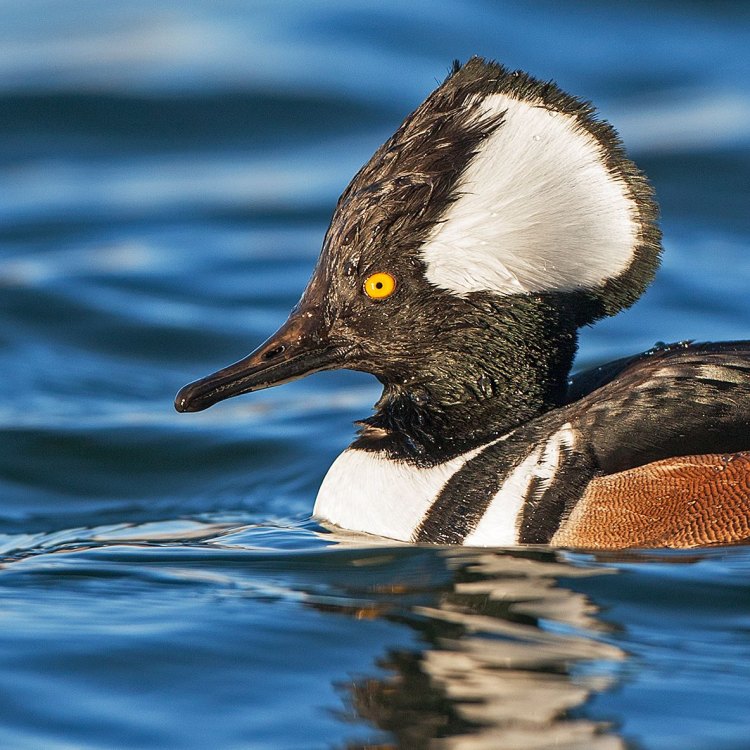
Merganser
- Adult Size: Medium to large
- Average Lifespan: 5-10 years
- Reproduction: Sexual
- Reproductive Behavior: Males perform elaborate courtship displays to attract females.
- Sound or Call: High-pitched, raspy calls.
- Migration Pattern: Some species are migratory, while others are year-round residents.
- Social Groups: Mergansers are usually seen in small flocks or pairs.
- Behavior: They are excellent divers and swim underwater to catch fish.
- Threats: Habitat loss, pollution, fishing nets, and hunting
- Conservation Status: Least Concern
- Impact on Ecosystem: Mergansers play a role in maintaining the balance of aquatic ecosystems by controlling fish populations.
- Human Use: Hunting and birdwatching
- Distinctive Features: Long, thin beak and a crest on the head
- Interesting Facts: Mergansers can swim and dive underwater to catch fish. They have a serrated beak to help them hold slippery prey.
- Predator: Bald eagles, ospreys, and larger predatory fish
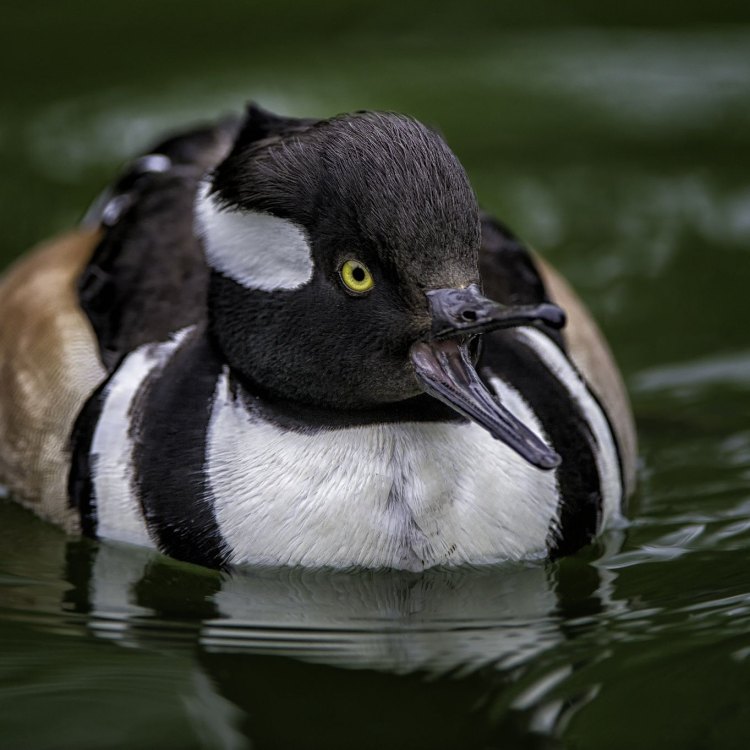
Mergus merganser
The Fascinating World of Mergansers: Nature's Versatile Divers
Nature has a way of captivating us with its unique and diverse creatures. One such creature is the merganser, a medium to large-sized waterfowl that is part of the duck family. They are fascinating birds that have a vital role in the delicate balance of aquatic ecosystems. In this article, we will explore the intriguing world of mergansers and discover what makes them stand out from other waterfowl PeaceOfAnimals.Com.Appearance and Size
Mergansers are known for their distinctive appearance, with the males sporting a striking black and white plumage with a green head and a thin, red bill. Females, on the other hand, have a more subtle grey and white coloring with a reddish-brown head. These birds are medium to large in size, ranging from 20-30 inches in length and weighing between 2-3 pounds.Life Expectancy and Reproduction
Mergansers have a relatively short lifespan, with an average of 5-10 years in the wild. They are sexually reproductive and breed mostly in the northern parts of their range during the spring and summer seasons. Male mergansers perform elaborate courtship displays to attract females, which often involve head-bobbing, wing-flapping, and splashing in the water.Voice and Migration
Mergansers are known for their high-pitched, raspy calls that are mostly heard during the breeding season. They are found in different parts of the world, with some species being migratory, while others are year-round residents. These birds can travel long distances during migration, sometimes reaching over 1000 miles Maltese Mix.Social Behavior and Habitat
Mergansers are highly social birds that are usually seen in small flocks or pairs. They prefer to inhabit freshwater lakes, rivers, and streams, where they can find an abundance of fish, their primary source of food. These birds are exceptional divers and swim underwater to catch fish, using their unique serrated beak to help hold slippery prey.Threats and Conservation Status
Like many other species of waterfowl, mergansers also face threats to their survival, mostly due to habitat loss, pollution, fishing nets, and hunting. However, thanks to conservation efforts and protections in place, the overall merganser population is stable, and they are currently listed as Least Concern on the IUCN Red List.Role in the Ecosystem
Mergansers play a significant role in maintaining the balance of aquatic ecosystems. As they mostly feed on fish, they help control their populations, preventing overpopulation, which can cause harm to other aquatic species. They also contribute to nutrient cycling by consuming and excreting fish, which helps fertilize and enrich the waters they inhabit.Human Use and Conservation Efforts
Humans have a long history of interacting with mergansers, both positively and negatively. While they have been hunted for their meat, feathers, and eggs, they are also cherished for their beauty and recreational value. Birdwatching is a popular activity among nature enthusiasts, with mergansers being a sought-after species for their unique appearance and behaviors.There are also numerous conservation efforts in place to protect and preserve mergansers, ensuring their survival for generations to come. These efforts include maintaining and restoring their habitats, monitoring their population levels, and educating the public about the importance of these birds to the ecosystem.
Distinctive Features and Adaptations
What makes mergansers truly remarkable are their unique features and adaptations. One of the most noticeable is their long, thin beak, which is perfectly designed for catching and holding onto slippery fish. Additionally, male mergansers also have a crest on their head, which they can raise or lower depending on their mood or to attract potential mates.Another incredible adaptation is their ability to swim and dive underwater to catch fish. Mergansers have a streamlined body and sleek feathers that make them excellent divers, while their eyes are specially adapted to see clearly underwater. They also have a serrated beak, which helps them to hold onto their slippery prey, making them highly efficient hunters.
Interesting Facts about Mergansers
Aside from their unique features and behaviors, there are many interesting facts about mergansers that make them stand out from other waterfowl. For instance, did you know that they can swim up to 60 miles per hour underwater? Or that they can dive up to 100 feet deep and stay underwater for up to 2 minutes? These birds are truly impressive creatures that have adapted well to their aquatic lifestyle.Mergansers also have a unique way of grooming themselves. Instead of using their beaks to preen, they use their feet to comb through their feathers, a behavior rarely seen in birds. They have also been observed stealing food from other waterfowl, including other mergansers, a cunning tactic to save energy and ensure a meal.
Predators and Threats
Despite their amazing adaptations, mergansers are still vulnerable to predators in the wild. Their main predators include bald eagles, ospreys, and larger predatory fish, which prey on these birds and their eggs. Their habitats are also under constant threat, with the decline of wetlands and water quality putting them at risk.While mergansers may face threats and challenges in their natural habitat, they continue to thrive and adapt to their ever-changing environment. These versatile divers have captured the hearts of bird lovers and play a vital role in maintaining healthy and balanced aquatic ecosystems.
In conclusion, mergansers are indeed fascinating creatures that offer a glimpse into the complexity and diversity of the natural world. Their distinctive features, behaviors, and adaptations make them stand out among other waterfowl. As we continue to learn more about these birds and their vital role in ecosystems, we must also work towards ensuring their survival and preserving their habitats for future generations to appreciate their beauty and value.
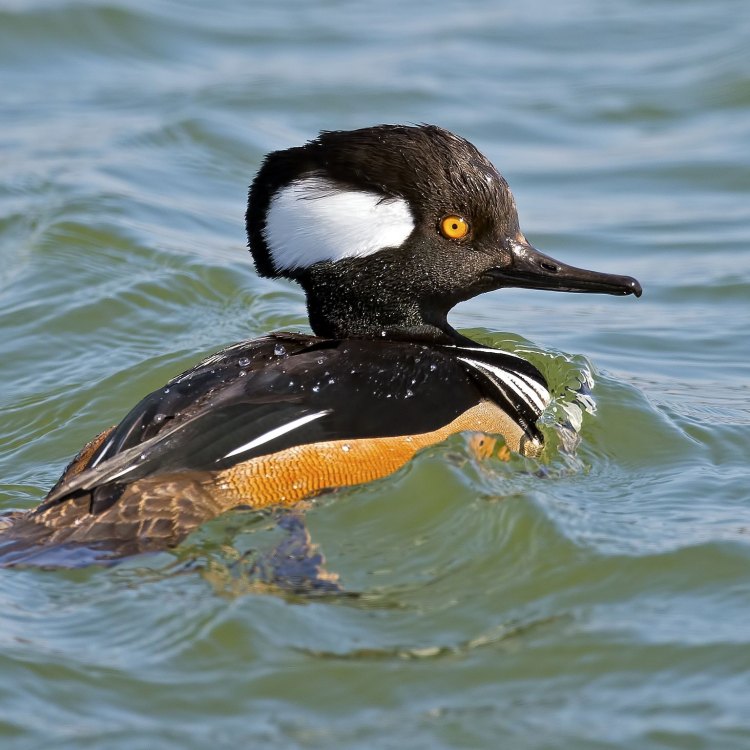
The Fascinating World of the Merganser: An Aquatic Bird Like No Other
Disclaimer: The content provided is for informational purposes only. We cannot guarantee the accuracy of the information on this page 100%. All information provided here may change without prior notice.


